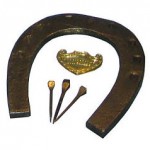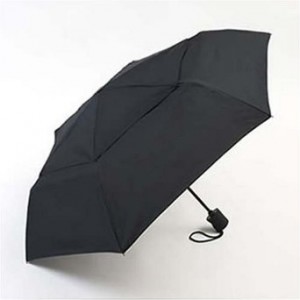Convert Features Into “Avoid Negative Outcomes” Benefits With The “For Want Of A Nail” Method

They say that you should sell holes instead drills, but the link between a feature and its benefit isn't usually that obvious
Indeed, customers buying drills aren’t buying features like 1/2″ drill bits. What they really want is the benefit of making perfect 1/2″ holes easily.
This makes sense to me, so I understand why many marketers say to “sell the hole, not the drill”.
So when I started writing this article about features and benefits, I thought I’d check out the product descriptions for some drills. Surely, they’d be chock full of benefits and not features?
Alas, they’re not! Take a look at the bestselling high-performance drill on Amazon. The product description’s first listed feature is the weak “Supplies 330 in./lbs. of torque”.
Is 300 in./lbs. a lot of torque? Maybe 300 in./lbs. of torque means that I can drill into hard brick? Or make holes in drywall in 3 seconds?
I guess I’ll never know.
It’s sad. Even drill makers can’t be bothered to turn their features into benefits. Black & Decker’s marketers must have heard the saying, so the reason can’t be ignorance.
The answer must be because it’s hard to convert features into benefits.
So the question is this: How can we easily convert “features that tell” into “benefits that sell”?
The “Rephrase Features As Benefit” Method Is Just Too Simple
Most articles about features and benefits go something like this. First, they define features and benefits.
A feature is a fact about a product.
A benefit is an advantage the customer enjoys.
Then, they give a simple example:
Feature: These boots have sealed seams.
Benefit: Your feet won’t get wet.
It seems so simple… Just rephrase your feature as a customer benefit, and you’re done!
The problem is this simple “rephrase features as benefits” process is too simple to work.
The Two Reasons Why The “Rephrase Features As Benefit” Method Is Too Simple To Work
The first problem is that the benefit “your feet won’t get wet” is true of every waterproof boot in the world.
If a benefit doesn’t show how your product is better than competitive products, that benefit won’t help you sell.
The second problem is simply that the “rephrase feature as benefit” method usually requires intuitive leaps. It’s not a step-by-step method that works reliably.
For a simple product, it might take just one step to get from “waterproof boot” to “dry feet”. But it takes a lot more than one step to get from most features to their benefits.
And even if you’re a copywriting genius, making frequent intuitive leaps quickly ain’t gonna happen.
This is particularly true when you’re dealing with a complicated tech product.
Introducing the “For Want Of A Nail” Method
A few months ago, I realized that I needed to find a new method to turn features into benefits that worked consistently without requiring intuitive leaps. That was the only way to create a method that reliably turns features to benefits.
I googled and googled, and came up with nothing.
Then, one day, I came across this old-timey poem:

A horse shoe nail attaches a horse shoe to the bottom of a horse's hoof. If the nails fall out, the horse shoe will fall off. This can cause the horse to become lame.
For Want of a Nail
For want of a nail the shoe was lost;
For want of a shoe the horse was lost;
For want of a horse the battle was lost;
For the failure of battle the kingdom was lost—
All for the want of a horse-shoe nail.
It hit me! That’s exactly what we need to do!
This poem gives us a perfect roadmap for generating benefits for any feature.
Let’s see how this works by using the poem to generate benefits for a horse-shoe nail product with the feature that it never falls off.
The poem explicitly lists five negative outcomes (and implies one more) that occur when somebody uses a product without the features of your product:
- Lost cheap horse-shoe nail
- Lost expensive horse-shoes
- Lost even more expensive horses
- Lost important battle
- Lost entire kingdom
- [Implied] Die on the battlefield or be executed by the new king
Now, to turn these negative outcomes into benefits, we can just reverse the negative outcomes, like this:
- Avoid losing cheap horse-shoe nails
- Avoid losing expensive horse shoes
- Avoid losing even more expensive horses
- Avoid losing important battles
- Avoid losing your kingdom
- Don’t die
If you were marketing superior horse-shoe nails, you could promote whichever of the above benefits most appeals to your target market. For instance, “avoid losing your expensive horse” might appeal to a calvary officer. “Avoid losing important battles” might appeal to a general, and “don’t die” appeals to everybody.
See how this method works? 🙂
The best part of this method is that each negative outcome naturally follows the previous outcome. You don’t have to make an intuitive leap from “avoid losing cheap horse-shoe nail” to “avoid losing entire kingdom”. One negative outcomes follows the next. And avoiding a negative outcome gives you a benefit!
There are no intuitive leaps needed!
So to convert features into benefits reliably, we need to first write our own “For Want Of A Nail” poem that lists each of the negative outcomes that occur when people use a product without the feature our superior product has.
Then, we just reverse those negative outcomes to get our benefits.
“Convert features to benefits by reversing the negative outcomes created by products without that feature.” – Click To Tweet
The Six Step Method For Turning Features Into Benefits Using The “For Want Of A Nail” Method
Here’s how this method works to convert a feature into a benefit for a real product. There are six steps:
Step 1: Understand Your Product’s Feature
Before we can turn a feature into a benefit, it helps to understand what the feature does. Let’s take a look at a specific feature of a great product that I happen to own: the ShedRain WindPro Mini Umbrella.
The feature we’re going to convert into a benefit is what ShedRain calls a “vented canopy”. They note cryptically that this feature is “engineered to resist windy conditions”.
What does this mean? Well, instead of the umbrella being covered by a single piece of waterproof material, it has two pieces of waterproof material. There’s an inner piece that goes in the middle. That inner piece overlaps the outer piece, so that rain never drips on you. In other words, an umbrella with a vented canopy is still an umbrella.What makes this better than a regular umbrella is that if wind gusts underneath the umbrella, the wind will “slip through” the “vented canopy” instead of turning the umbrella inside-out, which soaks you with rain and breaks the umbrella.
(This umbrella is actually really sweet. You should buy it.)
Step 2: Find a Competitive Product Without This Feature
The second step is to find a competitive product that does NOT have this feature. There are three types of “competitive products” that you can use:
- a similar product that a competitor offers
- an alternative product in a different product category that serves the same need, e.g. you could compare your hammock to a bed
- the DIY alternative, e.g. a customer doing taxes by hand is the “do it yourself” alternative to tax software
In this case, let’s go with a similar competitive product, a cheap folding umbrella that you buy for five bucks when it starts raining and you realize you don’t have an umbrella.
Step 3: Think of a “For Want Of Nail” Scenario Where Your Product’s Feature Would Help The User
The next step is to think of a “For Want Of Nail” Scenario where your product’s feature helps the user overcome obstacles.
For instance, the “vented canopy” feature helps when it’s very windy. So that’s the “For Want Of Nail” Scenario we’re going to imagine happening.
Step 4: Write a List of Outcomes That Happens When You Use the Competitive Product in That “For Want Of Nail” Scenario
Next, we’re going to write our own “For Want Of Nail” poem that lists the outcomes that occur when you use the competitive product in the “For Want Of Nail” Scenario. The poem actually only lists negative outcomes, but I find it helps to list all the outcomes leading up to the negative outcomes. It’s just easier.
So start the list by describing the “For Want Of Nail” Scenario. Then, write a list of the subsequent outcomes that would happen to that competitive product in that scenario.
For our umbrella, the list for the “cheap umbrella” competitive product might look something like this:
- Wind blows while it rains
- You open your cheap umbrella
- Wind gusts buffet your umbrella
- You angle your umbrella into the wind so the umbrella doesn’t jerk out of your hand
- A wind gust comes from a different direction that pulls the umbrella away from you
- The umbrella “inverts”
- You get soaked
- The fragile umbrella ribs break (or are damaged)
- Your umbrella is ruined
- You have to buy a new umbrella (frequently)
Step 5: Identify the Obstacle and the Opportunity Cost
Next, identify the first negative outcome that you want to avoid. In the poem, it’s when the horse-shoe nail is lost. I call this the Obstacle.
In the example above, the first negative outcome is #6: The umbrella “inverts”. That’s the Obstacle.
The negative outcomes listed after the Obstacle are what I call the Opportunity Costs. In other words, those negative outcomes are the prices customers pay for not using your great product with this feature.
In our example, the Opportunity Costs are #7 through #10:
- You get soaked
- The fragile umbrella ribs break (or are damaged)
- Your umbrella is ruined
- You have to buy a new umbrella (frequently)
Step 6: Define the Benefit By Reversing the Obstacle and Opportunity Costs
OK, we’re almost done!
The benefit of using a product with a particular feature is avoiding the Obstacle so that you don’t pay the Opportunity Costs.
You can phrase the Benefit by using this formula:
Benefit = [Avoid Opportunity Cost] in [General Scenario] With [Feature]
There are typically several Opportunity Costs. Pick the one that best works for that particular product and market. I find that the most powerful Opportunity Cost is often the outcome immediately after the Obstacle (e.g. #7: “You get soaked”).
Let’s try this Benefit Headline template for this Opportunity Cost for our “vented canopy” feature:
Feature = Vented Canopy
General Scenario: High Winds
Opportunity Cost = Getting Soaked By Rain
The Benefit Headline would be:
Benefit = [Avoid Opportunity Cost] In [General Scenario] With [Feature]
Benefit = [Avoid Getting Soaked By Rain] In [High Winds] With [Our Vented Canopy Umbrella]
You can also skip mentioning the Feature in your Benefit Headline. Benefits are what customers really want.
You can also express [avoid Opportunity Cost] in a positive way. For instance, instead of “Avoid Getting Soaked By Rain”, you might say “Stay Dry Even In Windy Rainstorms”.
Once you have the basic Benefit Headline, you can wordsmith it to your heart’s content. 🙂
You can also pick other Opportunity Costs besides the one immediately after the Obstacle. It all depends on the customer segment you’re marketing to. For instance, say you’re marketing to door-to-door salesmen in rainy Seattle. The most powerful Opportunity Cost might be based on “#10: You have to buy a new umbrella (frequently)”, because they’d be spending a ton of money on fragile umbrellas.
What’s Next
- Follow the steps above to convert a list of features into a list of benefits. Then create a split test and see if listing benefits improves your conversion rate.
- If you found this useful, please share it with your friends. 🙂
- Let me know what you think in the comments!
